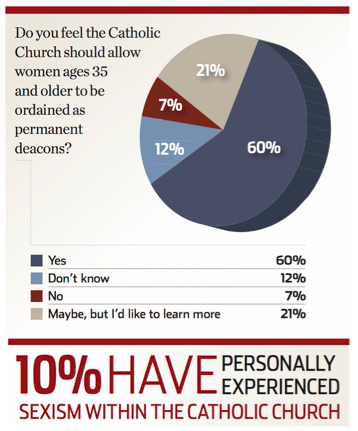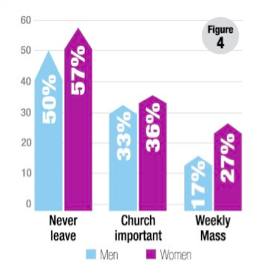Looking at Women: Data, Data, Data

The why: Is it “propitious” or pure chance that this week the National Catholic Reporter and America both feature the results of major surveys about American Catholic women? Are you reading this before or after the march in your community? Are you going as a Catholic feminist? I hope you do.
The who: The surveys were designed by the same organization, the Center for Applied Research in the Apostolate at Georgetown University (CARA), and the survey itself by the GfK Group. CARA’s women principals, Michelle Dillon in NCR and Mary Gauthier (co-authored with Mark M. Gray) in America wrote the lead articles. I make two peevish distinctions that might be considered Jesuitical. One is that the NCR article is about a survey of women and men, and the editor of America claimed “No one had ever done a comprehensive survey of Catholic women. So we did.” Really? The other is that the editorial in America notes that they “continue to oppose legal abortion, an unfortunate inclusion in the official platform of that march. But we stand in solidarity with every woman and man … who marched a year ago.” Solidarity is good. Hope you are out there today or tomorrow, too.
The what: far too much data to do either survey justice, so I will use this blog often to highlight and compare some of the findings. Scientists determine the validity of studies by replicating results, and these two surveys find much the same thing about women’s weekly mass attendance, 31% in NCR and 35% in America. Gray and Gauthier note that the margin of sampling error is plus or minus 2.5%, so this result is outside it. I combined the finely-differentiated categories in the America survey to include those who attended almost every week with those who went every week or more than once a week, which perhaps indicates my less-scrupulous approach to mass. If I were asked if I went every week, I would say “yes” unless the option of “almost once a week” were presented to me.
What would be compromising to the assumptions of the study in my response, however, is that I attend an intentional Eucharistic community, independent of the hierarchy, and yet identify as Catholic. These surveys do not elicit that information. But the overwhelming response I have to these studies is the immense presence of the institutional church, like looking at the Cathedral from a women’s ordination witness across the street. This huge church, not us, is the elephant in the room. And so I accept the validity of these studies of Catholic women and that I am a minority.
The most telling result is in the America question “Do you feel the Catholic Church should allow women ages 35 and older to be ordained as permanent deacons?”

Would you have phrased the question that way? Of course not. It does reflect the caution of the America survey, yet the 61% outright approval of this small step suggests that women are open to women’s leadership. The survey may have done us a favor in suggesting to another 21% that this was an issue to be explored further.
And further, of course, more than 10% of us in WOC could claim that we personally had experienced sexism — because of the exclusion of women from the priesthood. These respondents did feel excluded from ministry, many as altar servers. 15-25% of those were educated in Catholic colleges and high schools, had considered religious life, or had served in parish ministry – our demographic.
The other result I will highlight today is the church commitment of millennials (born 1982 or after). The NCR survey, because of women and men, highlights the differences, but I focus on young women’s responses.

Attendance is less important to these respondents than long-term commitment. Somehow more than half of these young women have been exposed to the faith enough to feel that they will never leave. They are our audience to lead the church in the future.
More to come from these surveys, about politics, birth control and abortion, and belief. But finally, I want to affirm the valuable role of the Catholic press. While we might be frustrated by the conservative decisions they sometimes make, we can be grateful when they focus on issues near and dear to us – ones we march for.

4 Responses
I wish I had particiipated, and with a lot of comments.
We need ordained women priests.
I hope we have a role in the church.
I do not feel I belong.
I prefer going to a church that has ordained woman. Denomination is not important to me, I study at a Lutheran Church.
Sue Nelson
It is lamentable that a question about women priests was not included. More men will go to church when we have women priests.
We need to look at women, but we also need to look at men, and we need to look at women and men in communion with each other as members of the body of Christ?
This is of course the focus of the Theology of the Body, in which everything can be seen in several dimensions and in perfect unity: body/soul, man/woman, husband/wife, Christ/Church, humanity/ecology…
The Theology of the Body is a radical deconstruction of PATRIARCHAL GENDER IDEOLOGY…
http://pelicanweb.org/CCC.TOB.html#PGT&TOB
TRY IT… YOU WILL LIKE IT! 🙂
Every Catholic woman and man has experienced SEXISM in the Church whether they know it or not, acknowledge it or not. Exclusion from a Sacrament on the basis of sex is SEXISM.
It upsets me to think that the Church hierarchy will draw men from a very young age into studies for the priesthood and ordination but that such formation cannot be given to women till 35 years of age. That is still putting women in a subordinate position.